As the winter transfer window moves closer to its deadline day, many teams across Europe are trying to secure their last few additions which will benefit them during the second stage of their respective domestic leagues. Amid the fact that they are star players who can provide decent quality for the squad, or they are just back-up players or young stars which the club aim to develop in a long-term run, they are all considered as additions to what is assumed a tough second period for many teams.
Among those teams who are trying to finalise their last few deals in this window, AC Milan are one of those teams as they are searching for a new left-back to replace Ricardo Rodríguez, who is rumoured to be leaving the club, and can become a long-term choice for Rossonero when Theo Hernández returns to Real Madrid. While there are many names across Europe where they can secure for a decent price, they turn their attention towards the EFL Championship for a left-back who is playing for a relegation-battle club.
Indeed, as the rumours have circulated in the last few weeks, the Serie A club are looking at Antonee Robinson, the English-American left-back and a key player for Wigan Athletic. While this can be considered as a surprising move, there are reasons behind Milan’s decision of scouting the 22-year-old full-back. This tactical analysis scout report will provide an analysis of Antonee Robinson’s first half of the season with Wigan. Meanwhile, using statistics and footages, we will take a look at the strengths and weaknesses that he has shown across this season in Cook’s tactics.
Overview and style of play
Robinson is an academy graduate from Everton’s academy as he attempted to force his way into the first team in the 2017/18 season. Still, two loans later on with Bolton Wanderers and Wigan Athletic were not enough to prove that he has the quality to play for the Merseyside-based club and Wigan quickly captured his service for a reported fee of 2.2 million Euros.
Now in his second season with The Latics, he has had a wealth of experience playing in the Championship after thriving in two seasons earlier with Bolton and Wigan. Right when he arrived at the DW Stadium, he had emerged as one of the first choices for manager Paul Cook when he picked his side to play in the Championship. Along with Reece James, who is now become a key player for Chelsea, they created a dynamic wing-back duo that stole the spotlight last season for Wigan.
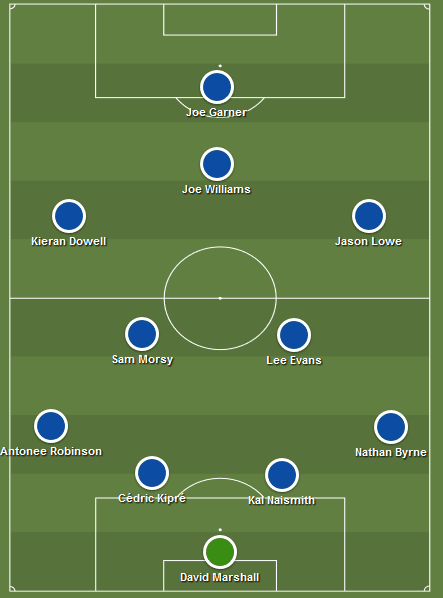
Playing in his preferred position of a left wing-back in Cook’s 4-2-3-1 formation, Robinson provides a balanced style of play as he has the ability to join the attack while can also track back and provide cover for his teammates. With Nathan Byrne on the opposite side, they act as two attacking full-backs who tend to overlap up the pitch and provide an attacking option from out wide. On several occasions, it is viable to see them involved in the build-up phase with centre-backs Cédric Kipré and, surprisingly, Kal Naismith (wait, I thought he is a winger; how did he end up as a centre-back?!).
As he overlaps up the pitch, the winger in front of him, Kieran Dowell, will tuck inside and open up the left flank for him to enter. With the ability of making good use of his pace, he can burst forward in seconds to receive the ball out wide and then send crosses into the box to meet the head of Joe Garner or late arrivals such as Lee Evans or Joe Williams. Still, since both wingers are playing on the same side with their preferred foot, they can drift wide on several occasions and allow Robinson and Byrne to turn inverted and move into the half-spaces, similar to the shot below.
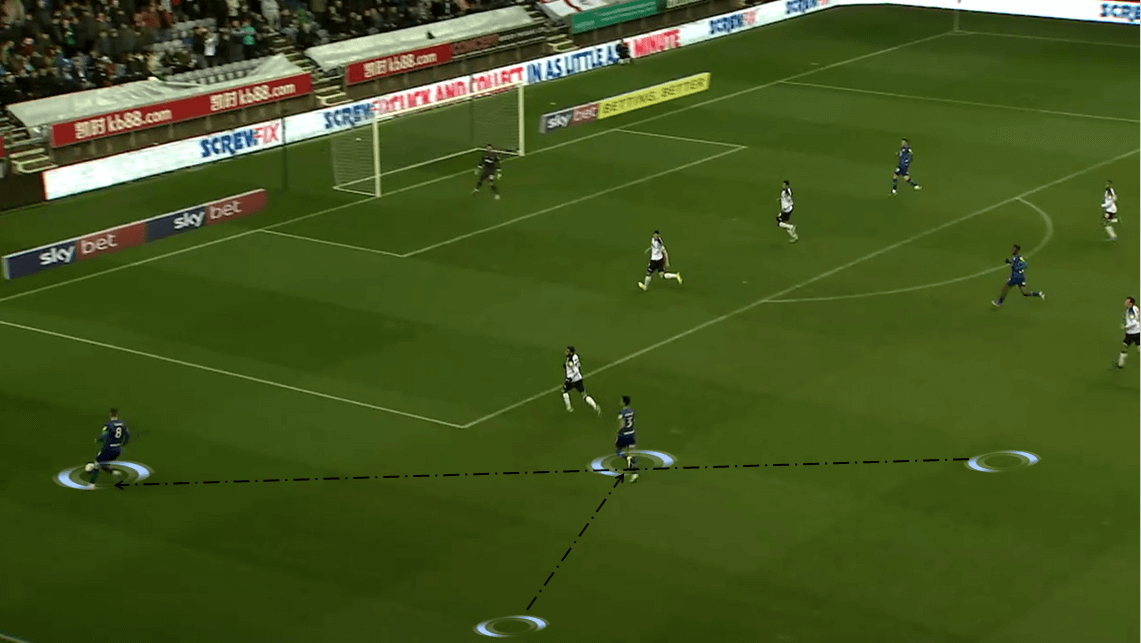
Pace and off-the-ball movements
When mentioning Robinson, one of the first strengths that are on every Wigan fans’ lips is his outstanding pace. The young full-back boasts with good acceleration and sprint speed, which he has shown in almost every matches he played this season. Just a few seconds earlier, he is still positioning himself in the opposition’s final third and looking at the opponent creating a counter-attack. Seconds later, he already arrives in his team’s half to join the defensive situation and support the remaining defenders.
There is a situation, in which is not possible to use a still image to describe just like Ben White’s sprint when Leeds played against Salford City this season, where Robinson showed his full sprinting ability during the team’s defensive transitioning period. It was the situation against Swansea City in the 56th minute where Swansea, the home side, attempted to create a counter-attack. Down the unoccupied left-hand side, Robinson started to sprint from the opposition’s half back into his team’s half and it only took him just seven seconds to reach the 16-yard box.
Often at the end of those sprints, Robinson tends to find himself standing in a good position to win the ball back from the opposition. With him being able to read the situation while tracking back into the team’s half, this allows him to pick out a spot where he can gain an advantage compared to the ball carrier. The situation below in Wigan’s match against Swansea indicated that trait of his clearly as he identified a gap in between Sam Morsy and André Ayew and allowed him to sprint into it right away. Later on, he was able to get in front of Ayew for a tackle which regained possession for his side.
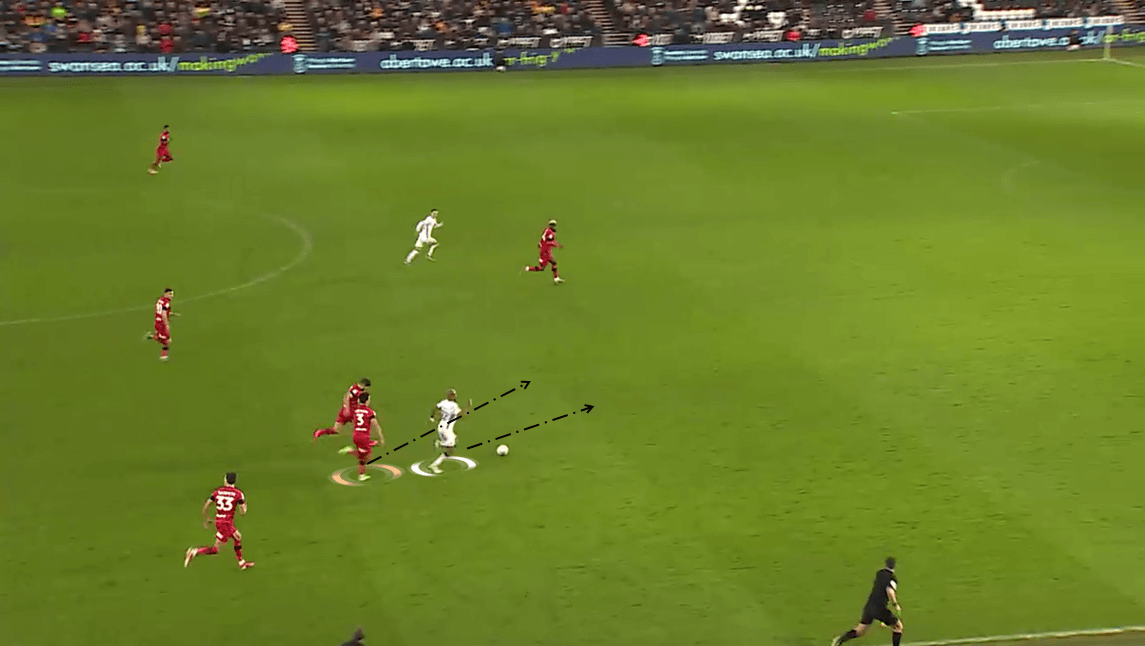
Boasting with his pace, it is hard to argue that Robinson has the ability to become such a dangerous threat with his off-the-ball movements. But that does not mean he would just run in a random direction or being ball-oriented during those situations. By being able to read the situation well and identify the pass, he can make the most of his pace to stay in front of the opposition’s player and allow himself to be in a positive state to intercept that pass.
Furthermore, timing his run well is another crucial part that really contributes to his defensive ability. When he can do so, he will find himself stepping into that player’s running direction which will lead him into a 1v1 duel and allow him to pick up the ball either in the air or from a tackle. This is another trait that Robinson likes to capitalise over the course of this season as he combines at best his pace and vision to read not just the situation but also the game in order to find a position where he can contribute to the team’s defensive situation.
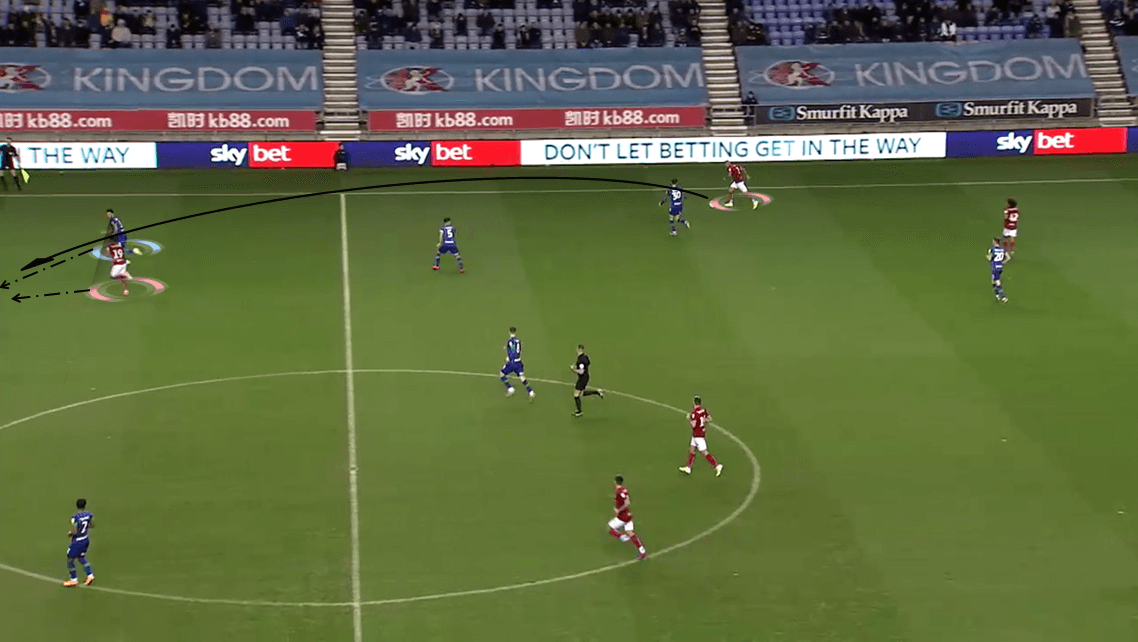
Besides being able to use his pace during defensive situations, he also utilises it to contribute to the team’s attack. As mentioned, he plays in the role of an attacking left-back who tends to overlap up the pitch while Dowell plays inside the left half-space. With Wigan being a wing-oriented team, this becomes one of their main attacking methods since it is viable for Robinson to link up with his teammates even from out wide.
During several occasions, it is possible to see Robinson bursts forward after making a one-two pass with his teammate. As they attract the attention of the opposition’s defenders, this will create gaps behind their back and this is where Robinson likes to play the most. He tends to capitalise these space by encouraging the midfielders to make through balls into that area and he will pick it up using their pace.
Against teams who play with a low-block, Robinson can go around the defensive lines and then cut back to open up channels where the creative midfielders such as Williams or Dowell can pass into. There, either himself or another attacking player will pick up the ball; and if that scenario happens, Robinson can be found near the vertical byline as he attempts to sprint towards the horizontal one and ready to receive the ball.
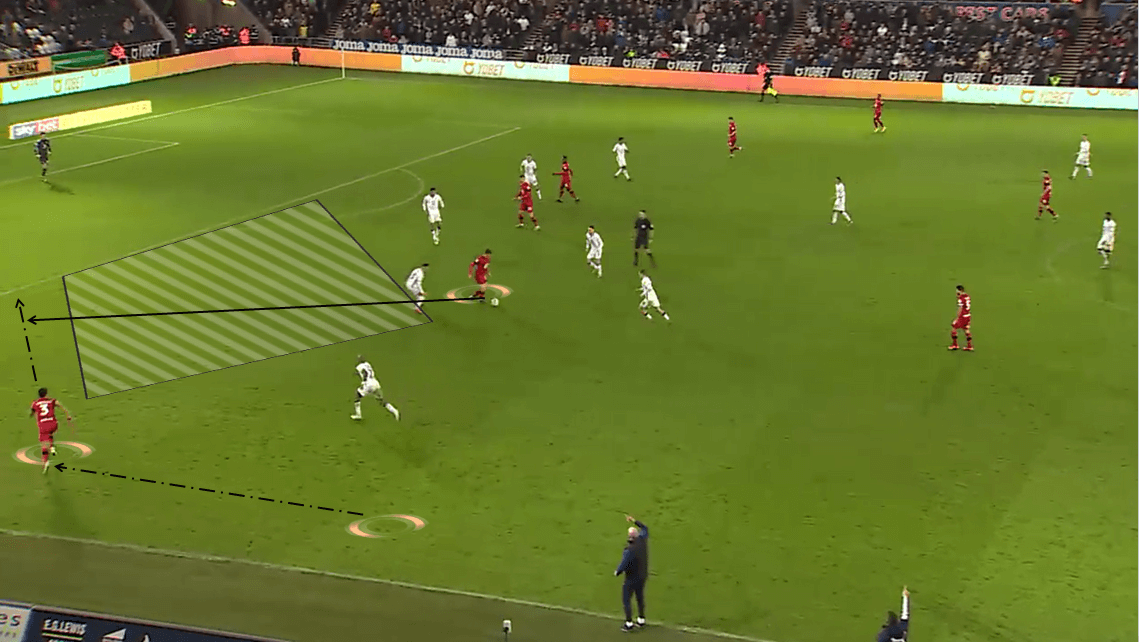
Dribbling and attacking output
Off-the-ball, he proves himself as an intelligent runner who usually capitalises gaps that are created by the opposition using his pace. A similar thing also happens when he has the ball with him being a decent dribbler thanks to, once again, his pace and a confident mentality. Across all competitions that he has played this season, he creates an average of 4.83 dribbles and 3.5 progressive runs per 90 minutes. His dribbing success percentage is also at a decent rate with 56.55% of his dribbles are completed.
Those numbers are backed by his performances on the field whenever he controls the ball from inside his team’s half. Another strength that he shows this season is his low centre of gravity, which allows him to be more agile in his dribble. He tends to lean his body forward a bit whenever he attempts a sprint, either on- or off-the-ball. This allows him to stay on his feet more often and able to stand still against a tackle from the opposition. When he gains a stable speed, he will adjust his body vertically and continue his run while reading the situation.
Furthermore, with him being a technical player, it helps him to bypass the pressure that comes from the opposition’s defender through some small techniques. In the situation below against Middlesbrough, he demonstrated it perfectly as he noticed there was a significant gap behind his marker. In order to bypass him, he surged forward a bit to invite that player to involve in a duel and then nutmegged him to continue moving the ball forward.
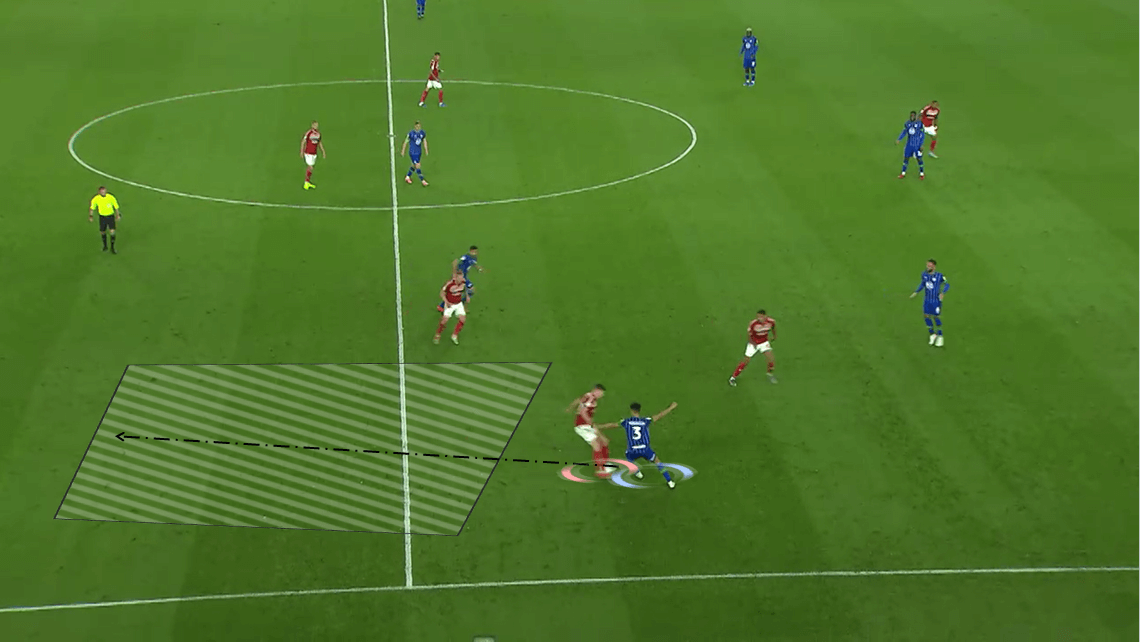
In the role of an attacking wing-back, besides the dribbling ability, one player must also have a decent crossing ability in order to drive the ball towards the destination that it is directed. Robinson is a decent crosser who tends to make low crosses into the box for the advanced options. But while he overlaps often, his average number of crosses per 90 minutes is not too high, which stands at 3.93 crosses per 90 minutes with an accurate rate of 36.44%. Still, that remains at a decent level as Robinson continues to push on for his first assist this season amid the number is expecting him to have at least one assist up to now (1.12 xA).

Given the good attacking output that he has shown, he still has a setback that needs to be improved on. He can be a good situation reader to pick out teammates who are in good position to pick up the ball and link up with them through one-two passes. But when Robinson gets suffocated by the opposition’s press, he tends to find himself getting confused and can’t find a good passing option to lay the ball towards.
He won’t show signs of frustration but will continuously look around to see if there is any teammate who has moved into space. Since they are all being marked, it is hard for Robinson to find one and this forces him to delay the ball for longer than expected. By using two players immediately closing him down like what Derby did below, the opposition will be able to win the ball back and start a counter-attack.
For Robinson, an advice in this situation is that he can always play the ball backwards even though he likes to progress the ball forward to help the team’s attack. The contrast in his progressive passes and back passes also highlights this, as the numbers currently stand at 9.56 and 4.8 per 90 minutes respectively. This shows the trend of him wanting to move the ball forward along with his teammates, but there are scenarios where it is better to make a back pass, which will recycle possession and allow the team to find a clear attacking method to execute.
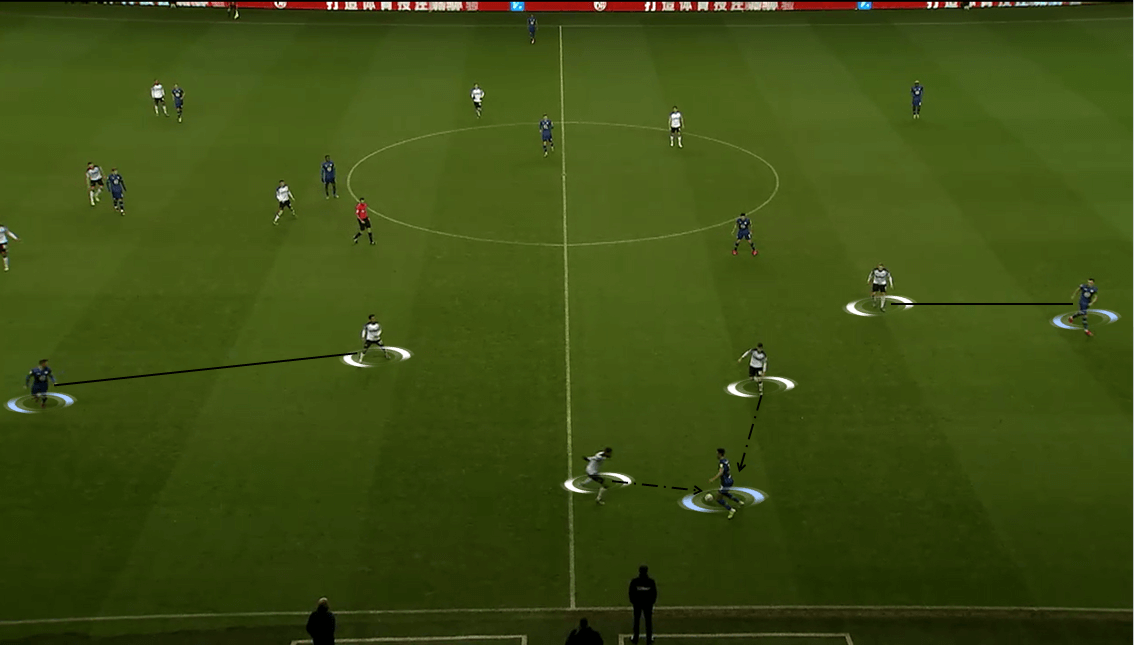
On the other hand, he also shows that he has the ability to score goals whenever possible. Amid the fact that he is still looking for his first assist this season, he was able to score his first professional goal and that came from the match against Millwall. Receiving the ball from the edge of the 16-yard box, Robinson moved a bit closer into the box as he aimed to drive the ball towards the direction of his teammate Anthony Pilkington. Instead, it went passed the former Norwich midfielder and left goalkeeper Bartorz Białkowski with no chance of saving it when it hit the bottom right corner.
But, in contrast to his total expected assist number, he is predicted to have at least half a goal from the chances that he has had (0.58 xG), which means he has a 50% chance of scoring a goal from those chances. Furthermore, 0.33 shots on target per 90 minutes and 30% of the total 10 shots that he made found the target are somewhat high figures for a left-back, which make the fact that Robinson deserves this goal more accurate.
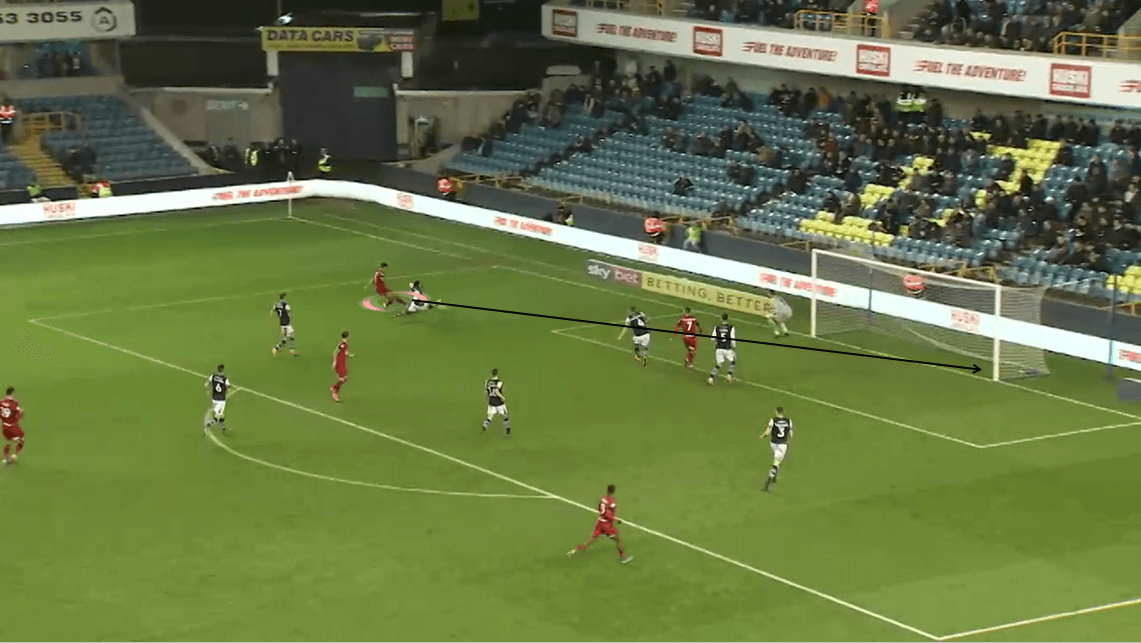
Anticipation, decision-making and defensive output
We have analysed about how Robinson does when he uses his pace to involve in the team’s defence and the outcome of those sprints where he found himself getting back into his team’s half in just a few seconds. But what about the other scenarios of his? One of the strengths that can be seen from his defensive actions is his anticipation, where he reads the ball direction and intercepts the passes.
It is somewhat similar to how he reads the situation and involves in the duel through a tackle or just by sticking a foot into it. Indeed, it is similar as this shows the ability of him knowing where those passes end up and where the ball will drop to outjump the opponent, which, in the end, related back to the ability of being able to read the situation. In the match against Swansea that dated back just more than ten days ago, Robinson performed a high-quality defending performance where he was consistent in helping his teammates to recover possession for his team. Along with the two scenarios that we have analysed earlier, there is another one that demonstrates as best his anticipation ability.
In the scenario below, Swansea were attempted to create an attack down their left-hand side but faced a discipline defensive structure that had already overloaded that flank. This forced them to change their attacking direction to the opposite side using a long pass from left-back Kyle Naughton. Meanwhile, Robinson was sticking to his marker Rhian Brewster and found himself far away from right-back Connor Roberts.
But by anticipating Naughton’s intention, Robinson was one step ahead of the veteran full-back as he stepped away from Brewster and left the risk of him being unmarked. He switched his marking player towards Roberts and attempted to position himself right in front of the Welsh full-back to intercept the pass, which he did eventually.
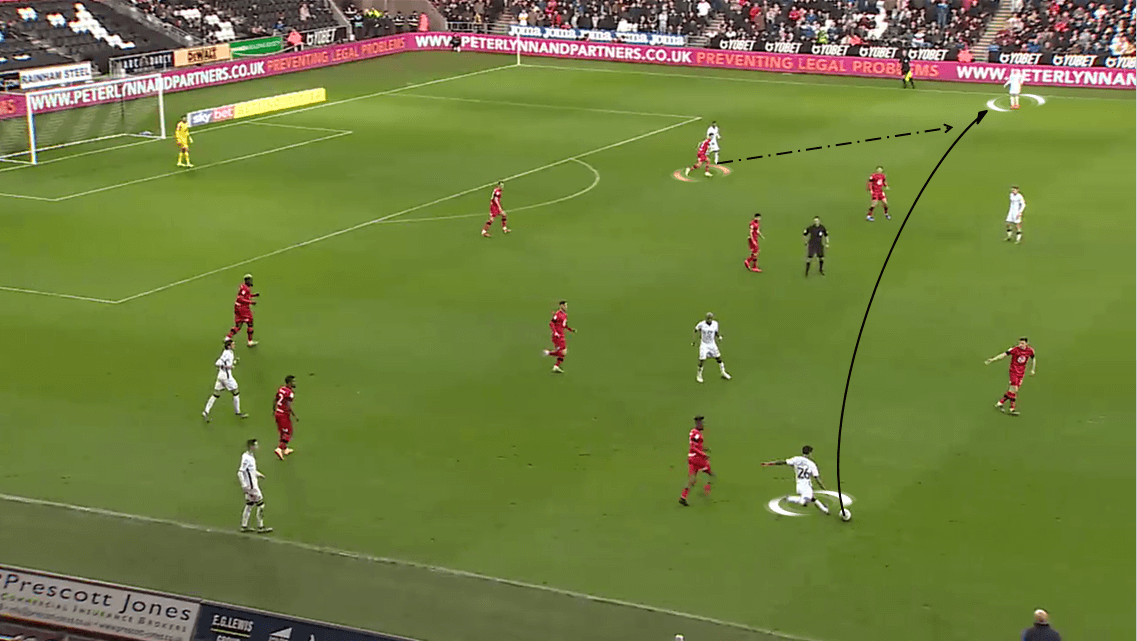
Along with anticipation, an ability that played a crucial role in the situation above, decision-making is also another thing that contributed to a success defending situation of Robinson. If he decided not to step out and remained with Brewster, the pass would be executed and Swansea would be able to start a new attacking wave from another side of the pitch. Furthermore, if he chose to step out later than Naughton’s pass, he would leave both Brewster and Roberts unmarked to link up to each other as this could have created a dangerous attack for Swansea.
Making a good decision can lead to your team able to regain possession for a counter-attack, while a bad one will put you in a negative state as you have to continue defending and lose one defender as he has to recover from his position. This statement can be said to the scenario below against Bristol City as Robinson was put in a 2v1 situation. In a similar situation like that, many defenders tend to be caught in pressure and, as a result, lose track of either one or both attacking players. Robinson, meanwhile, decided to stand in between them to intercept the pass that the ball carrier made and that forced a throw-in, which created time for Wigan players to reshape their defensive structure.
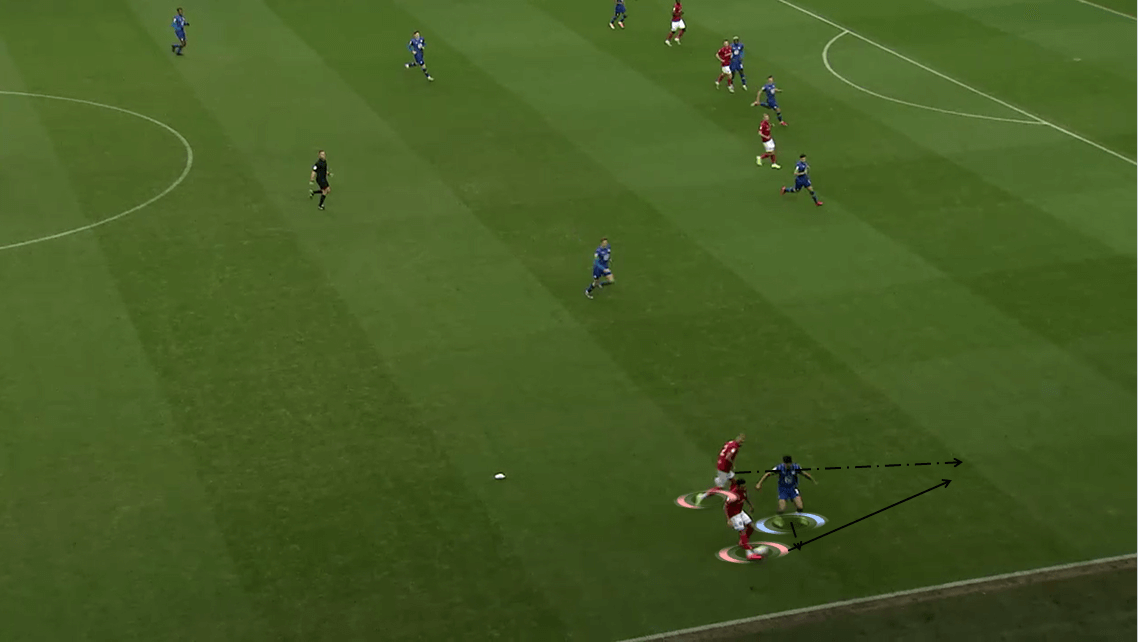
He shows that he is a good decision-maker during the team’s defensive situation which helps the team to recover possession, and the numbers back him for that. On average, he involves in 8.13 defensive duels per 90 minutes and won 64.75% of them. Furthermore, given that his height is at 1m83 (6’), he has decent height for a defender and this gains him an advantage while he participates in an aerial duel. The numbers of 2.63 aerial duels per 90 minutes and won 45.57% of them are decent for a full-back and this means he can become a useful helper in the air that can provide support for his teammates in set-pieces.
Moreover, Robinson is not the type of player who tends to dive into tackles as he prefers to stay on foot and win the ball back for his team. With only 0.37 tackles and 0.8 fouls per 90 minutes, this shows how hesitant Robinson is from making tackles and tends not to commit fouls often. To cover this up, he usually intercepts passes on a constant basis since he has the pace to get in front of the opponent and predict where will the pass go. With 6.33 interceptions and 9.07 interceptions per 30 opposition possession per 90 minutes, he is the third-best interceptors among Wigan squad just behind Cédric Kipré and Dujon Sterling.
Conclusion
While a move to AC Milan might be huge for Robinson himself, it will be a great chance for the youngster to prove himself at a higher level than the Championship. He can become a fierce competitor for the starting left-back position with Theo Hernández and even make it himself when Theo returns to Real Madrid and after a streak of good performances from Robinson.
Nonetheless, he has shown good improvements during the last three seasons playing in the Championship. While it is hard to judge if he has outgrown the league or not, it is clear that he has the potential to make it further than where he is standing now. With two USA caps under his belt, he will want to develop more in order to become a starter for both Wigan and his national team in the near future, in case that dream move to the San Siro might not go through.





Comments